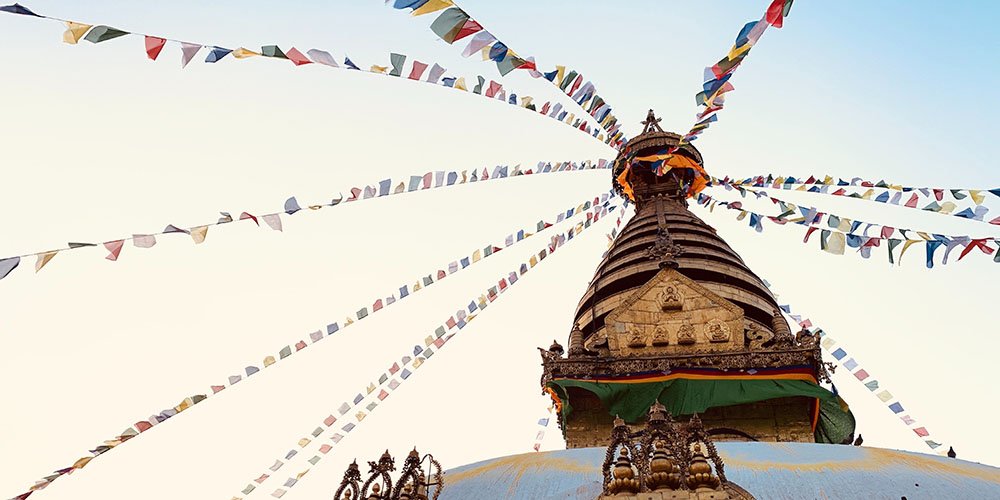Stupas in Hungary – Experience Their Magic!
The stupas in Hungary attract many different people. There are those who are interested in other religions and want to get to know their holy places. There must be some who are a little skeptical, but curious. And there are those who are interested in Buddhism – or have been following its teachings for years – so they want to experience the inimitable atmosphere of a Buddhist shrine.
The stupas in Hungary are not only nice to look at though, they offer much more to those interested. But where exactly can you find them? And what can you expect in these places? And by the way: exactly what is a stupa? Read on and get an answer to all your questions.
Stupa – a Buddhist Building
A stupa is a characteristic shape in Buddhis architecture. Its origins are a simple mound of earth – the burial place of the remains of the Buddha, which were cremated and distributed into eight stupas.
The building itself is made up of five elements. It stands on a rectangular base on which a hemispherical vault is placed, on which we a conical apex. There is also a sickle and a disc on each stupa. Of course, none of the parts are accidentally placed on each other, they are symbols for the five elements: earth, water, fire, air and space.

Stupas in Hungary
The first stupa in Hungary was built in 2008. Since then, a total of seven similar buildings have been erected in Hungary, three of which are located in public areas and four in private areas. The latter can also be visited, but only by prior arrangement. In this article, we want to focus on the four locations that anyone is free to go to. Let’s look at them more closely!
Kőrös Stupa (Tar)
When visiting Tara, we will be greeted not only by a stupa, but also by the Memorial Park named after Sándor Kőrösi Csoma which offers countless opportunities. Next to the Peace Temple there is a Museum dedicated to the Dalai Lama himself and blessed by representatives of other world religions. In addition, the park houses the Tara Temple – or Temple of the Savior Buddha Mother – which was built for the happiness of all living things.
But we also find other leisure opportunities here: take a walk in the fresh air, walk around the estate! You will be captivated by the immeasurable tranquility of the place, the kind of endless peace that floods every square inch of it. While walking here, be sure to check out the shop, where many treasures can be found, and taste delicious drinks at the Tara Tea House!
Béke Stupa (Zalaszántó)
Hungary’s first and most famous stupa is undoubtedly the Béke (Peace) Stupa in Zalaszántó, which was inaugurated by the 14th Dalai Lama. The place is already special to look at: it is 30 meters high, 24 meters wide, and its entire surface is dazzlingly white, making it stand out from its fabulous green surroundings, and on its surface we can see several Buddhist symbols.
Inside the shrine, small parts of the Buddha’s earthly remains are preserved. It also contains a Buddha statue from South Korea, a huge tree of life, and some relics and teachings of the Buddha. The interior is not open for visitor, but this of course does not mean that the stupa cannot provide a complete experience for those who want to recharge from the spirit of the place.
In addition those interested can take part in meditation courses here, and various other programs such as a healing Buddha initiation.
Becskei Stupa
This stupa in Nógrád county which was completed in September 2008 is located in Csigahegy, next to the village. The so – called Enlightenment Stupa was inaugurated by Nepalese Buddhist master Serab Gyalcen Rinpoche. The building is nine meters high, making it relatively small, and has received contributions from countless locations, including Nepal.
Be sure to notice here that a gilded, seated Buddha statue can be seen at the top of the stupa. And the hillside behind the edifice, among the trees, is full of prayer flags. But we can also find information boards here, which provide information about the Buddhist life in Hungary, the main teachers.
It is important to note that this site has previously played a prominent role in the lives of Hungarian Buddhists. Even before 2008, international courses were often held here, as well as retreats that hosted thousands of believers from around the world.
Of the stupas in private areas, which are not accessible for visitors, two are located in Budapest, one in Budakeszi, and one in the Bükk Mountains, next to Bükkkmogyorósd.
So if you want to visit a Buddhist stupa and experience its special atmosphere, there is no need to travel to Tibet or Nepal just for that reason – even though these great countries are always worth a visit.
And if you would like to explore even more spiritual places in Hungary, you can read in detail about the Krishna Valley in Hungary.
For more information about yoga, meditation and a conscious lifestyle follow YogaYogi on Facebook!
 English
English magyar
magyar